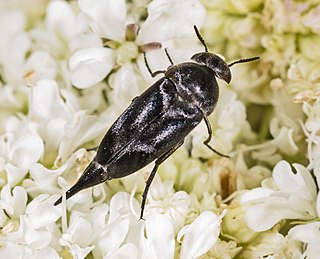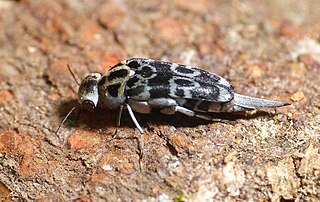Related Research Articles

The Mordellidae are a family of beetles commonly known as tumbling flower beetles for the typical irregular movements they make when escaping predators, or as pintail beetles due to their abdominal tip which aids them in performing these tumbling movements. Worldwide, there are about 1500 species.

Mordella is the type genus of the tumbling flower beetle family (Mordellidae), its subfamily Mordellinae and the tribe Mordellini. It is widely distributed in the Holarctic and adjacent regions. The larvae are primarily dead wood borers.
Glipodes is a genus of beetles in the family Mordellidae, containing the following species:

Glipa is a genus of beetles in the family Mordellidae, containing the following species:
Mordellaria is a genus of tumbling flower beetles in the family Mordellidae. There are more than 10 described species in Mordellaria.
Paratomoxioda is a genus of beetles in the family Mordellidae, containing the following species:
Sphaeromorda is a genus of beetles in the family Mordellidae, containing the following species:
Dellamora is a genus of beetles in the family Mordellidae, containing the following species:
Mordellina is a genus of tumbling flower beetles in the family Mordellidae.

Mordellistena is a genus of beetles in the family Mordellidae, containing the following species:
Stenalia is a genus of beetles in the family Mordellidae. It contains the following species:
Pseudotomoxia albonotata is a species of beetle in the genus Pseudotomoxia of the family Mordellidae, which is part of the superfamily Tenebrionoidea. It was described in 1936 by Eugene Ray.
Pseudotomoxia horni is a species of beetle in the genus Pseudotomoxia of the family Mordellidae, which is part of the superfamily Tenebrionoidea. It was described in 1936 by Eugene Ray.
Pseudotomoxia mosseliana is a species of beetle in the genus Pseudotomoxia of the family Mordellidae, which is part of the superfamily Tenebrionoidea. It was described in 1965 by Francisco.
Pseudotomoxia palpalis is a species of beetle in the genus Pseudotomoxia of the family Mordellidae, which is part of the superfamily Tenebrionoidea. It was described in 1965 by Francisco.
Pseudotomoxia quadrinotata is a species of beetle in the genus Pseudotomoxia of the family Mordellidae, which is part of the superfamily Tenebrionoidea. It was described in 1936 by Eugene Ray.
Pseudotomoxia rufoabdominalis is a species of beetle in the genus Pseudotomoxia of the family Mordellidae, which is part of the superfamily Tenebrionoidea. It was described in 1936 by Eugene Ray.
Pseudotomoxia trilineata is a species of beetle in the genus Pseudotomoxia of the family Mordellidae, which is part of the superfamily Tenebrionoidea. It was described in 1936 by Eugene Ray.
Pseudotomoxia trimaculata is a species of beetle in the genus Pseudotomoxia of the family Mordellidae, which is part of the superfamily Tenebrionoidea. It was described in 1936 by Eugene Ray.

Mordellinae is a subfamily of beetles commonly known as tumbling flower beetles for the typical irregular movements they make when escaping predators, or as pintail beetles due to their abdominal tip which aids them in performing these tumbling movements.
References
- ↑ Mordellidae Species List at Joel Hallan's Biology Catalog. Texas A&M University, archived from the original on 7 October 2014, retrieved 8 August 2015